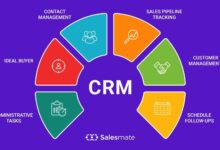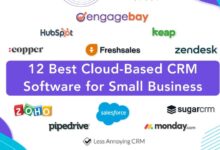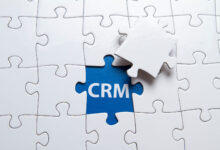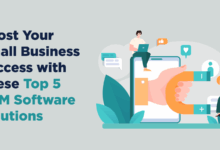Best Enterprise CRM Solutions: A Comprehensive Guide
Best Enterprise CRM Solutions are crucial for businesses aiming to streamline operations and enhance customer relationships. This guide delves into the selection, implementation, and optimization of enterprise-grade CRM systems, covering everything from identifying core functionalities and key performance indicators (KPIs) to navigating the complexities of vendor selection, integration, and security considerations. We’ll explore leading vendors like Salesforce, Microsoft Dynamics 365, and SAP CRM, comparing their features, pricing models, and target markets. Furthermore, we’ll address critical aspects such as data migration, change management, and maximizing return on investment (ROI).
Understanding the nuances of Sales Force Automation (SFA), customer service modules, and marketing automation within the enterprise context is paramount. We’ll analyze the essential reporting and analytics capabilities, providing a roadmap for successful CRM implementation and integration with existing enterprise systems like ERP and marketing automation platforms. Finally, we’ll address critical security and compliance requirements, ensuring data protection and adherence to regulations such as GDPR and CCPA.
Defining Enterprise CRM Needs
Implementing a successful enterprise CRM system requires a thorough understanding of the organization’s specific needs. A poorly chosen or implemented system can lead to wasted resources and a failure to achieve desired business outcomes. Careful planning and a clear definition of requirements are paramount to success.
Core Functionalities of an Enterprise CRM System
A robust enterprise CRM system must provide a comprehensive suite of functionalities to support various business processes. These functionalities can be broadly categorized into sales, marketing, and customer service modules, each with its own set of essential features. Critical functionalities include contact management, lead management, opportunity management, sales forecasting, marketing campaign management, customer service case management, and reporting and analytics. The system should also offer features for collaboration and communication, allowing teams to efficiently work together to manage customer interactions. For example, a robust contact management system would allow for detailed customer profiling, including purchase history, communication preferences, and interaction notes, all accessible across the organization. Similarly, a comprehensive sales forecasting module would utilize historical data and predictive analytics to provide accurate sales projections.
Key Performance Indicators (KPIs) for Enterprise CRM Success
Measuring the effectiveness of an enterprise CRM system requires a set of carefully selected KPIs that align with the organization’s strategic goals. These KPIs should provide insights into the system’s impact on key business processes and overall performance. Essential KPIs include sales conversion rates, customer acquisition cost, customer lifetime value, customer satisfaction scores (CSAT), Net Promoter Score (NPS), and return on investment (ROI). For instance, tracking the sales conversion rate helps to assess the efficiency of the sales process and identify areas for improvement. Monitoring customer satisfaction scores provides valuable feedback on the quality of customer interactions and service. Analyzing the ROI of the CRM system demonstrates its overall contribution to the organization’s profitability.
Integration Points with Other Enterprise Systems
Seamless integration with other enterprise systems is crucial for maximizing the value of an enterprise CRM system. This integration allows for a unified view of customer data and enables efficient workflows across different departments. Critical integration points include Enterprise Resource Planning (ERP) systems, marketing automation platforms, and e-commerce platforms. Integration with an ERP system enables access to real-time inventory data, order history, and financial information, providing a holistic view of the customer relationship. Integration with marketing automation platforms streamlines marketing campaigns and provides valuable insights into customer behavior. Connecting with e-commerce platforms allows for real-time tracking of online customer interactions and transactions. For example, integration with an ERP system allows sales representatives to instantly access inventory levels when discussing product availability with a customer, leading to improved sales and reduced lost opportunities.
Hypothetical Enterprise Structure and Corresponding CRM Needs
Consider a hypothetical mid-sized manufacturing company with three distinct sales teams (domestic, international, and direct sales), a marketing department running multiple campaigns, and a customer service team handling inquiries and complaints. This structure requires a CRM system capable of handling different sales processes, managing complex lead flows across various channels, and tracking marketing campaign performance. The CRM must also offer comprehensive reporting and analytics to provide insights into sales performance, marketing effectiveness, and customer service efficiency. The system needs to integrate with the company’s ERP system to access inventory levels and production schedules. Furthermore, it should integrate with marketing automation tools to manage email campaigns and track customer interactions. Finally, customer service interactions need to be efficiently tracked and managed within the CRM system, potentially using a ticketing system and knowledge base. The reporting features should allow for segmenting data by sales team, marketing campaign, and customer segment to provide tailored insights for strategic decision-making.
Top Enterprise CRM Vendors
Choosing the right enterprise CRM solution is crucial for business success. The market offers a variety of powerful platforms, each with its own strengths and weaknesses. Understanding the key features, pricing models, and target markets of leading vendors is essential for making an informed decision. This section will provide a comparative analysis of three prominent players: Salesforce, Microsoft Dynamics 365, and SAP CRM.
Leading Enterprise CRM Vendor Comparison
The following table offers a concise comparison of Salesforce, Microsoft Dynamics 365, and SAP CRM, highlighting their key features, pricing models, and target markets. It’s important to note that pricing can vary significantly based on specific configurations and add-ons.
| Vendor | Key Features | Pricing Model | Target Market |
|---|---|---|---|
| Salesforce | Extensive app ecosystem, robust automation capabilities, strong analytics, highly customizable, AI-powered features (Einstein). | Subscription-based, varying tiers with different functionalities and user limits. | Broad range of businesses, particularly those requiring high scalability and customization. Strong in sales and marketing automation. |
| Microsoft Dynamics 365 | Seamless integration with other Microsoft products (Office 365, Power BI), strong financial management capabilities, robust project management tools. | Subscription-based, modular pricing allowing for selection of specific modules. | Businesses that heavily utilize the Microsoft ecosystem, those needing strong financial and operational integration. |
| SAP CRM (now integrated into SAP Customer Experience) | Deep integration with SAP ERP systems, strong focus on customer service and support, robust data management capabilities. | Subscription-based or on-premise licensing, often part of a larger SAP enterprise suite. | Large enterprises with complex business processes and existing SAP infrastructure. |
Successful Enterprise CRM Implementations
Successful CRM implementations require careful planning and execution. Here are examples of successful deployments for each vendor:
Salesforce: Many large enterprises, including Adidas and Coca-Cola, have leveraged Salesforce to improve sales processes, customer engagement, and overall business efficiency. Adidas, for example, uses Salesforce to manage its global sales operations, providing real-time insights into sales performance and customer behavior.
Microsoft Dynamics 365: Companies like Mars and Unilever have successfully implemented Dynamics 365 to streamline their operations and improve customer relationships. These implementations often integrate with existing Microsoft systems, enhancing efficiency and data consistency.
SAP CRM: Large multinational corporations with complex supply chains, such as Siemens and BMW, have benefited from SAP CRM’s deep integration with their existing SAP systems, enabling streamlined data flow and improved operational efficiency. These implementations often focus on enhancing customer service and support across global operations.
Cloud-Based vs. On-Premise CRM for Enterprises
The choice between cloud-based and on-premise CRM solutions significantly impacts cost, scalability, and security. Cloud-based solutions offer advantages in terms of accessibility, scalability, and lower upfront costs, while on-premise solutions provide greater control over data and customization. However, on-premise solutions require significant upfront investment in infrastructure and ongoing maintenance. Many enterprises are moving towards hybrid models, combining the benefits of both approaches.
Scalability and Customization Options
Salesforce is widely recognized for its high scalability and extensive customization options, allowing businesses to adapt the platform to their specific needs as they grow. Microsoft Dynamics 365 also offers good scalability and customization, particularly when integrated with other Microsoft products. SAP CRM, while highly customizable, may require more specialized expertise due to its complexity and integration with the larger SAP ecosystem. The scalability of each solution depends on the specific implementation and chosen modules.
Key Features of Enterprise CRM Systems
Enterprise CRM systems are far more than simple contact databases; they are powerful platforms integrating various functionalities to streamline business processes and enhance customer relationships. Effective CRM implementation hinges on understanding and leveraging the core features designed to improve sales, service, and marketing efforts across the organization.
Sales Force Automation (SFA) Modules
SFA modules are the backbone of sales operations within an enterprise CRM. These modules automate and optimize various sales activities, contributing significantly to increased productivity and revenue generation. They provide a centralized repository for all customer and prospect interactions, enabling sales teams to track leads, manage opportunities, and forecast sales accurately.
- Lead Management: SFA systems allow for efficient lead capture, qualification, and assignment, ensuring no potential sales opportunities are missed. Features include lead scoring, automated routing, and lead nurturing workflows.
- Opportunity Management: These modules enable sales teams to track the progress of each sales opportunity, from initial contact to closing. This includes features like forecasting, pipeline management, and win/loss analysis.
- Contact Management: A centralized database stores comprehensive customer information, including contact details, interaction history, and purchase records, providing a 360-degree view of each customer.
- Sales Process Automation: SFA streamlines the sales process by automating repetitive tasks such as email marketing, appointment scheduling, and report generation, freeing up sales representatives to focus on relationship building.
Customer Service and Support Modules
In the enterprise context, effective customer service is paramount for customer retention and brand loyalty. Customer Service and Support modules within an enterprise CRM provide the tools necessary to deliver exceptional customer experiences and resolve issues efficiently.
- Case Management: This allows for tracking and managing customer inquiries and issues throughout their lifecycle. Features include automated routing, escalation procedures, and service level agreement (SLA) tracking.
- Knowledge Base: A centralized repository of information, including FAQs, troubleshooting guides, and product manuals, empowers both customers and support agents to resolve issues quickly and efficiently.
- Self-Service Portals: These portals allow customers to access support resources, submit tickets, and track the status of their inquiries independently, reducing the burden on support teams.
- Multi-Channel Support: Modern CRM systems integrate various communication channels, including email, phone, chat, and social media, providing customers with multiple ways to connect with support.
Marketing Automation Modules
Marketing automation modules within enterprise CRM systems empower marketing teams to execute targeted campaigns, personalize customer interactions, and measure campaign effectiveness. These modules help nurture leads, increase conversion rates, and build stronger customer relationships.
- Email Marketing: Automated email campaigns can be designed and deployed to nurture leads, announce new products, or promote special offers, with personalized messaging based on customer segmentation.
- Campaign Management: These modules allow for the creation, execution, and tracking of various marketing campaigns across multiple channels. This includes features like A/B testing, campaign optimization, and ROI analysis.
- Lead Nurturing: Automated workflows can be created to guide leads through the sales funnel, providing personalized content and communication at each stage of their journey.
- Social Media Integration: Integration with social media platforms allows for monitoring brand mentions, engaging with customers, and running targeted social media advertising campaigns.
Reporting and Analytics Capabilities
Enterprise CRM systems provide robust reporting and analytics capabilities, offering valuable insights into sales performance, customer behavior, and marketing effectiveness. This data-driven approach enables businesses to make informed decisions, optimize their strategies, and improve overall business outcomes.
- Sales Performance Dashboards: Real-time visualizations of key sales metrics, such as revenue, conversion rates, and sales cycle length, provide immediate insights into sales team performance.
- Customer Segmentation: CRM systems enable businesses to segment customers based on various criteria, such as demographics, purchase history, and engagement level, allowing for targeted marketing and personalized experiences.
- Marketing Campaign Analytics: Detailed reports on marketing campaign performance, including open rates, click-through rates, and conversion rates, provide valuable insights into campaign effectiveness.
- Predictive Analytics: Advanced CRM systems leverage machine learning to predict future customer behavior, such as churn risk or purchase likelihood, enabling proactive interventions.
CRM Implementation and Integration
Successfully implementing and integrating an enterprise CRM system requires a strategic approach that considers various factors, from careful planning and phased rollout to robust data migration and seamless system integration. A well-executed implementation minimizes disruption and maximizes the return on investment.
Implementing a new enterprise CRM system is a complex undertaking. A phased approach mitigates risk and allows for iterative improvements based on feedback. Careful planning is crucial for a successful outcome.
Phased Approach to CRM Implementation
A phased approach to CRM implementation allows for manageable deployment and reduces the risk of overwhelming the organization. Each phase builds upon the previous one, ensuring a smooth transition and minimizing disruption to daily operations. A typical phased approach might involve four key phases:
- Planning and Requirements Gathering: This phase focuses on defining project goals, identifying key stakeholders, and determining the scope of the implementation. It includes a detailed assessment of existing business processes, data requirements, and user needs. This phase culminates in a comprehensive project plan with timelines and resource allocation.
- Design and Configuration: This phase involves designing the CRM system to meet the specific needs of the organization. This includes customizing workflows, configuring user roles and permissions, and designing data entry forms. Data mapping and cleansing activities are also undertaken during this phase to prepare for data migration.
- Data Migration and Testing: This phase involves migrating existing customer data from legacy systems to the new CRM platform. Thorough testing is critical to ensure data accuracy and system functionality. This often includes parallel running of the old and new systems for a period of time to allow for comparison and verification.
- Deployment and Training: This final phase involves deploying the CRM system to end-users and providing comprehensive training. Ongoing support and maintenance are essential to ensure the continued success of the implementation. Post-implementation reviews are conducted to identify areas for improvement.
Data Migration to a New Enterprise CRM Platform
Data migration is a critical step in CRM implementation. It requires careful planning and execution to ensure data accuracy and completeness. The process typically involves several steps:
- Data Assessment: This involves analyzing the existing data, identifying data quality issues, and developing a data cleansing strategy. This includes identifying duplicates, inconsistencies, and missing data.
- Data Mapping: This involves mapping the fields in the legacy system to the corresponding fields in the new CRM system. This ensures that data is transferred correctly and can be easily accessed and used in the new system.
- Data Cleansing: This involves correcting errors, removing duplicates, and filling in missing data. This improves the quality and accuracy of the data transferred to the new CRM system.
- Data Transformation: This involves converting the data into a format that is compatible with the new CRM system. This may involve data type conversions or other transformations.
- Data Migration: This involves transferring the cleaned and transformed data to the new CRM system. This can be done using various methods, such as batch processing or real-time integration.
- Data Validation: This involves verifying the accuracy and completeness of the migrated data. This often involves comparing the data in the new system to the data in the legacy system.
Challenges and Best Practices for CRM Integration with Existing Enterprise Systems
Integrating CRM with existing enterprise systems, such as ERP, marketing automation, and e-commerce platforms, presents several challenges. Successful integration requires careful planning and the use of appropriate integration technologies.
- Data Synchronization: Maintaining data consistency across multiple systems requires robust data synchronization mechanisms. Real-time synchronization is often preferred for optimal data accuracy but can be more complex to implement.
- Data Security: Ensuring data security across integrated systems is crucial. This requires careful consideration of access controls and data encryption.
- Integration Technologies: Choosing the right integration technologies, such as APIs or ETL tools, is essential for seamless data exchange. The choice depends on the specific systems involved and the level of integration required.
- Testing and Validation: Thorough testing and validation of the integrated systems are essential to ensure that data is exchanged correctly and that the systems function as expected. This includes testing data flow, security, and performance.
Successful Change Management Strategies During CRM Implementation
Successful CRM implementation requires effective change management to ensure user adoption and maximize the return on investment. Key strategies include:
- Communication: Regular communication with stakeholders is essential to keep them informed of progress and address concerns. This includes providing updates on the implementation timeline, training schedules, and system functionality.
- Training: Comprehensive training is crucial to ensure users understand how to use the new system effectively. This includes both classroom-based training and online resources.
- User Involvement: Involving users in the implementation process helps to build buy-in and ensure that the system meets their needs. This can include user feedback sessions and beta testing.
- Incentives and Recognition: Providing incentives and recognition for early adopters and those who actively participate in the implementation process can encourage user adoption.
- Ongoing Support: Providing ongoing support and maintenance is essential to ensure that the system continues to function effectively and that users have access to assistance when needed. This can include help desks, online forums, and user manuals.
Cost and Return on Investment (ROI)
Implementing an enterprise CRM system represents a significant investment, but the potential return can be substantial. Understanding the associated costs and developing a robust ROI strategy is crucial for successful deployment and maximizing business benefits. This section outlines a hypothetical cost breakdown, explains ROI calculation, and explores strategies for maximizing return and identifying cost-saving opportunities.
Hypothetical Cost Breakdown of Enterprise CRM Implementation
The total cost of implementing an enterprise CRM system can vary greatly depending on the size of the organization, the chosen vendor, the level of customization required, and the complexity of the integration process. The following represents a hypothetical breakdown for a mid-sized company:
| Cost Category | Estimated Cost |
|---|---|
| Software Licenses (per user, per year) | $100 – $500 |
| Implementation Services (consulting, configuration, data migration) | $50,000 – $200,000 |
| Training and User Adoption Support | $10,000 – $50,000 |
| Ongoing Maintenance and Support (annual) | $5,000 – $25,000 |
| Customizations and Integrations (if needed) | Variable, potentially significant |
This is a general estimate, and actual costs can fluctuate significantly. Factors like the number of users, the complexity of integrations with existing systems (e.g., ERP, marketing automation), and the extent of required customization will heavily influence the final price tag. For instance, a large enterprise with thousands of users and complex integration needs would expect considerably higher costs.
Calculating ROI of Enterprise CRM Implementation
Calculating the ROI of a CRM implementation requires a careful assessment of both costs and benefits. A common approach involves comparing the total cost of the implementation with the increase in revenue or cost savings generated. The formula for ROI is:
ROI = (Net Profit / Total Investment) x 100%
To calculate net profit, identify quantifiable benefits like increased sales, improved customer retention, reduced customer service costs, and increased sales efficiency. For example, a company might see a 10% increase in sales, a 5% reduction in customer support calls, and a 15% improvement in sales conversion rates. These improvements would need to be translated into monetary value to accurately assess the net profit generated. A comprehensive cost-benefit analysis should be performed prior to implementation to project potential returns accurately.
Strategies for Maximizing ROI from Enterprise CRM
Effective CRM implementation requires a strategic approach. Several key strategies can maximize the return on investment:
- Clearly Define Goals and Objectives: Establish measurable goals before implementation, aligning them with business objectives. This ensures the CRM system directly contributes to key performance indicators (KPIs).
- Data Migration and Cleansing: Ensure accurate and clean data migration. Inaccurate data renders the CRM ineffective.
- Comprehensive User Training: Provide thorough training to all users, fostering adoption and maximizing system utilization. Effective training ensures users understand the system’s capabilities and how to leverage it effectively.
- Ongoing Monitoring and Optimization: Continuously monitor system performance and user behavior. Regular adjustments and improvements will ensure the CRM remains a valuable asset.
- Integration with Existing Systems: Seamless integration with other business systems minimizes data silos and enhances efficiency. This avoids data duplication and improves overall data accuracy.
Potential Cost-Saving Opportunities Through CRM Implementation
Enterprise CRM systems offer several cost-saving opportunities:
- Reduced Customer Support Costs: Improved customer service efficiency and self-service capabilities lead to fewer support calls.
- Improved Sales Efficiency: Streamlined sales processes and better lead management reduce wasted time and resources.
- Reduced Marketing Costs: Targeted marketing campaigns and improved customer segmentation lead to higher ROI on marketing spend.
- Better Inventory Management: Integration with inventory systems minimizes stockouts and overstocking, reducing storage and disposal costs.
Security and Compliance
Protecting sensitive customer and business data within an enterprise CRM system is paramount. Robust security measures and adherence to relevant compliance regulations are crucial not only for maintaining data integrity but also for safeguarding the company’s reputation and avoiding potentially significant legal and financial repercussions. This section details the critical security and compliance considerations for enterprise CRM deployments.
Data Encryption and Access Controls
Data encryption is a fundamental security measure for enterprise CRM systems. This involves converting data into an unreadable format, preventing unauthorized access even if the data is intercepted. Different encryption methods exist, including symmetric encryption (using the same key for encryption and decryption) and asymmetric encryption (using separate keys). Strong encryption algorithms, like AES-256, should be implemented to protect data both at rest (stored on databases and servers) and in transit (during transmission over networks). Access controls, implemented through role-based access control (RBAC) systems, are equally vital. RBAC ensures that only authorized personnel can access specific data and functionalities within the CRM system, based on their roles and responsibilities. This minimizes the risk of data breaches caused by unauthorized access. For instance, a sales representative might only have access to customer data related to their assigned accounts, while a system administrator would have broader access privileges.
Compliance Requirements for Enterprise CRM Data
Enterprise CRM systems must comply with various data privacy regulations depending on the geographical location of the data and the users. The General Data Protection Regulation (GDPR) in the European Union and the California Consumer Privacy Act (CCPA) in California are prominent examples. GDPR mandates stringent data protection standards, including the right to be forgotten, data portability, and explicit consent for data processing. CCPA grants California consumers similar rights, including the right to know what data is collected, the right to delete data, and the right to opt-out of data sales. Compliance necessitates implementing appropriate technical and organizational measures to ensure adherence to these regulations. This includes documenting data processing activities, providing data subjects with access to their data, and responding promptly to data subject requests. Failure to comply can result in substantial fines and reputational damage.
Data Backup and Disaster Recovery Planning
Data backup and disaster recovery (DR) planning are crucial for ensuring business continuity in case of data loss or system failures. Regular backups of the CRM database should be performed, stored securely in a separate location (preferably offsite), and tested regularly to ensure data recoverability. A comprehensive DR plan should outline procedures for restoring the CRM system and data in case of various disaster scenarios, such as natural disasters, cyberattacks, or hardware failures. This plan should include details on data recovery timelines, communication protocols, and the roles and responsibilities of different team members. A robust DR plan minimizes downtime and data loss, ensuring business operations can resume quickly after an incident. For example, a company might use cloud-based backup services and a geographically redundant data center to ensure data availability even in the event of a local disaster.
Security Protocol for an Enterprise CRM System
A comprehensive security protocol for an enterprise CRM system should encompass several key elements:
- Regular Security Audits and Penetration Testing: Regular security assessments identify vulnerabilities and ensure the system’s security posture remains strong. Penetration testing simulates real-world attacks to identify weaknesses before malicious actors can exploit them.
- Multi-Factor Authentication (MFA): MFA adds an extra layer of security by requiring users to provide multiple forms of authentication, such as a password and a one-time code from a mobile device, before accessing the system. This significantly reduces the risk of unauthorized access even if passwords are compromised.
- Intrusion Detection and Prevention Systems (IDPS): IDPS monitor network traffic and system activity for suspicious behavior, alerting administrators to potential security threats and automatically blocking malicious activities.
- Employee Security Awareness Training: Regular training educates employees about security best practices, such as strong password management, phishing awareness, and safe internet usage, minimizing the risk of human error-related security breaches.
- Data Loss Prevention (DLP) Tools: DLP tools monitor data movement and prevent sensitive information from leaving the organization’s control without authorization. This helps prevent data breaches and ensures compliance with data privacy regulations.
Final Summary
Ultimately, selecting and implementing the best enterprise CRM solution requires a strategic approach that considers business needs, budget constraints, and long-term goals. By carefully evaluating vendors, features, and integration points, organizations can leverage CRM systems to improve customer relationships, optimize sales processes, and achieve a significant return on investment. This guide provides a solid foundation for navigating this complex landscape and making informed decisions that will drive business growth and success.





